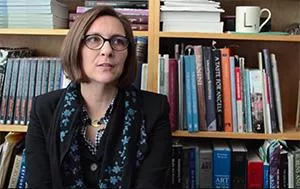
Celebrating an outstanding art history researcher
Evonne Levy, professor and art historian in the Department of Visual Studies at the University of Toronto Mississauga, will deliver this year's Desmond Morton Research Excellence Lecture.
The lecture takes place Wednesday, January 30 from 3 to 5 pm in the UTM Room (DV-3140), in the Davis Building on the U of T Mississauga campus.
Levy is the 2017-18 recipient of the Desmond Morton Award, which recognizes outstanding career achievement in research and scholarly activity by U of T Mississauga faculty. Award recipients receive $5,000 towards research activity and/or professional development.
“I’m extremely proud to have been recognized for my research,” says Levy, expressing that research is an extension of creativity and that it is not just a matter of quantity, but of a variety of approaches and a diversity of topics. “I feel that this award recognizes the growth I’ve had as a scholar and researcher.”
Levy says that her research has taken her from the study of objects to the study of the people who ask the questions of the objects—the art historians—and back again.
- Evonne Levy: Baroque, Bernini and Art History
- Roman Report
- 18-minute clip of Reading Wölfflin's Principles documentary
Originally trained as a scholar of Italian Baroque art, Levy says her first major projects were on the art and architecture of the Jesuits through the lens of propaganda. Her work on this global religious order led to a major collaboration on the Hispanic Baroque with colleagues in Spain, Portugal and Latin America.
“This marked a big foray into a global approach to my discipline as well as an interdisciplinary one,” says Levy.
Another major area of Levy’s interest is the historiography of modern art history, specifically the writings on the Baroque style by the discipline’s German-speaking founders.
“For around 15 years, I researched the archives of modern Swiss and German art historians,” says Levy. “I researched how art history arises from diverse political situations, expressed as the political views of art historians, and rehearses political thought.”
Understanding that scholarly work has a very personal dimension is something that Levy brings to her teaching. “I think it is very difficult for students to see the person in what they are reading,” she says. “And students are even more alienated now from authors because the digital realm gives the illusion that there are no authors. There are no people behind the things that we read.”
Her historiographical work also led to her research into the global readership of a single art historical text. It is this study that will be the subject of her Research Excellence Lecture.
Wölfflin’s Principles of Art History is a foundational text familiar to every art historian. The book, she says, attempted to theorize the visual appearance of objects. Although it is about European art, it was translated so widely, it was understood as a book that could be applied to world art.
“It was applied to Japanese, Chinese, colonial Latin American art. It had this massive diffusion so that even though a lot of the reaction to it was negative, and its premises were challenged, somehow it’s like a phoenix in the ashes,” says Levy. “It continues to rise over and over again despite art history’s 100-year-long habit of trying to kill it off.”
Professor Alison Syme, former chair (2013-18) of Visual Studies, nominated Levy for the Desmond Morton Research Excellence Award. Levy’s scholarship is exciting, according to Syme, because whatever the subject of her research at any given moment, she asks questions that are relevant to the history and evolution of the discipline of art history as a whole.
Levy’s first book, Propaganda and the Jesuit Baroque is a good example. Levy argues that historians working on Baroque art should not ignore how it became a topic of study, and in the book she uncovers "the connections between the 20th-century German scholars who produced ‘Baroque' as a category and National Socialism,” creating some controversy.
Since then, Levy has continued to bring a greater awareness of the politics of early art historical scholarship to the field. Recent projects have explored the influence of Wölfflin’s classic text Principles of Art History and the art of the Hispanic Baroque. Syme describes her as “a formidable researcher and thinker, and a tireless organizer of international collaborative projects and conferences.”
While still in what Levy calls “the end-game” of her work on Wölfflin’s text, she has already begun the groundwork on a new research project. Early Modern Intermediality heralds a return to thinking and writing about objects. Levy says she is getting out of the heads of art historians and into the heads of artists, and “that is a good shift.”
Please RSVP to Rong Wu if you would like to attend the Research Excellence Lecture featuring Professor Evonne Levy on January 30.
